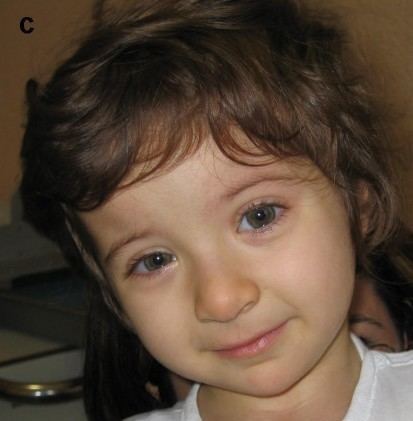Specialty medical genetics ICD-9-CM 759.89 DiseasesDB 29344 | ICD-10 Q87.2 OMIM 180849 MedlinePlus 001249 | |
 | ||
Rubinstein–Taybi syndrome (RTS), also known as broad thumb-hallux syndrome or Rubinstein syndrome, is a condition characterized by short stature, moderate to severe learning difficulties, distinctive facial features, and broad thumbs and first toes. Other features of the disorder vary among affected individuals. People with this condition have an increased risk of developing noncancerous and cancerous tumors, leukemia, and lymphoma. This condition is sometimes inherited as an autosomal dominant pattern and is uncommon, many times it occurs as a de novo (not inherited) occurrence, it occurs in an estimated 1 in 125,000-300,000 births.
Contents
Features of Rubinstein–Taybi syndrome
A case was described in 1957 by Michail, Matsoukas and Theodorou. In 1963, Jack Herbert Rubinstein (1925–2006) and Hooshang Taybi (1919–2006) described a larger series of cases.
Typical features of the disorder include:
A 2009 study found that children with RTS were more likely to be overweight and to have a short attention span, motor stereotypies, and poor coordination, and hypothesized that the identified CREBBP gene impaired motor skills learning. Other research has shown a link with long-term memory (LTM) deficit. See also Epigenetics in learning and memory.
Genetics
Rubinstein–Taybi syndrome is a microdeletion syndrome involving chromosomal segment 16p13.3 and is characterized by mutations in the CREBBP gene. The CREBBP gene makes a protein that helps control the activity of many other genes. The protein, called CREB-binding protein, plays an important role in regulating cell growth and division and is essential for normal fetal development. If one copy of the CREBBP gene is deleted or mutated, cells make only half of the normal amount of CREB binding protein. A reduction in the amount of this protein disrupts normal development before and after birth, leading to the signs and symptoms of Rubinstein–Taybi syndrome.
Mutations in the EP300 gene are responsible for a small percentage of cases of Rubinstein–Taybi syndrome. These mutations result in the loss of one copy of the gene in each cell, which reduces the amount of p300 protein by half. Some mutations lead to the production of a very short, nonfunctional version of the p300 protein, while others prevent one copy of the gene from making any protein at all. Although researchers do not know how a reduction in the amount of p300 protein leads to the specific features of Rubinstein–Taybi syndrome, it is clear that the loss of one copy of the EP300 gene disrupts normal development.
1 out of 100,000 to 125,000 children are born with RTS.
